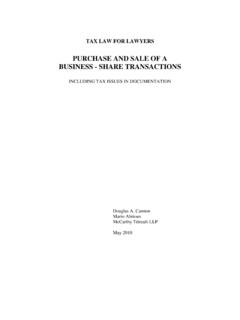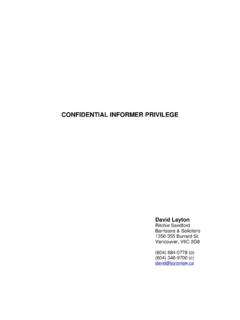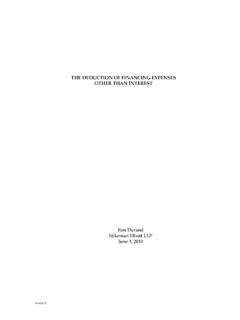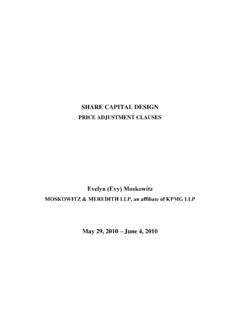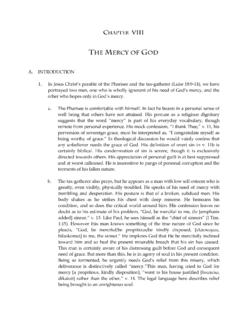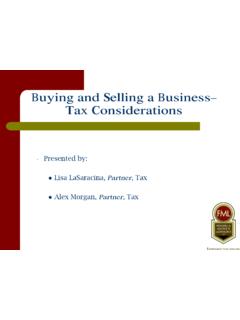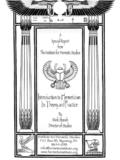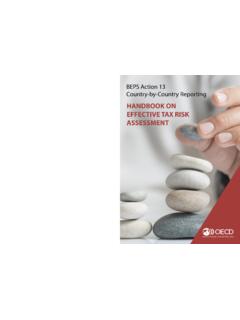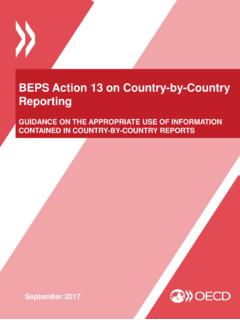Transcription of INTRODUCTION TO TAX ATTRIBUTES - Canadian …
1 INTRODUCTION TO TAX ATTRIBUTES . MICHAEL D. TEMPLETON. TABLE OF CONTENTS. INTRODUCTION TO TAX ATTRIBUTES .. 1. BASIC ACCOUNTING CONCEPTS .. 1. Shareholders' 1. Retained Earnings (Earned Surplus) .. 1. Contributed Surplus .. 1. STATED CAPITAL .. 1. Definition .. 1. Adjustments to Stated Capital .. 2. Adjustments .. 2. 2. Additions .. 2. PAID-UP CAPITAL .. 3. Definition .. 3. Deemed Dividends .. 4. Stock Dividends .. 4. Capitalization of 4. WHERE PUC DEPARTS FROM STATED CAPITAL .. 5. ADJUSTED COST BASE .. 9. Definition .. 9. Components of 10. V-Day Value Adjustments .. 11. Section 52 Cost 11.
2 Adjustments to ACB .. 12. (i). Additions to ACB .. 13. Deductions from ACB .. 13. Identical Properties Rule .. 14. Negative ACB .. 15. Allocating and Manipulating ACB .. 15. DISPOSITION AND PROCEEDS OF DISPOSITION .. 17. Definition of Disposition .. 17. Definition of Proceeds of Disposition .. 18. Proceeds of Disposition of Non-Capital Property .. 19. Section 20. THE STOP-LOSS RULES .. 20. The Concept of Affiliated Person .. 21. Specific Stop-Loss Rules .. 21. Losses on Shares that Are Capital Property and on which Dividends Have Been Received (Subsection 112(3)) .. 22. (ii).
3 BASIC ACCOUNTING CONCEPTS. Shareholders' Equity The shareholders' equity account on a corporation's balance sheet represents the value of assets less liabilities. Shareholders' equity consists of three accounts - share capital, contributed surplus (if any) and retained earnings. Retained Earnings (Earned Surplus). Retained Earnings represent accumulated undistributed income net of any losses, miscellaneous charges and dividend payments. Contributed Surplus Where contributions are made to a corporation and these contributions are not added to a particular stated capital account, such amount is generally added to contributed surplus.
4 The CICA defines contributed surplus as: 1. Surplus contributed by shareholders, being the premium received on the issue of par value shares, the portion of proceeds of issue of no par value shares that has been allocated to surplus, the proceeds of sale of donated shares, profit on forfeited shares, credits resulting from redemption or conversion of shares at less than the amount set up as share capital or any other contributions in excess of stated value of shares made by shareholders as such. 2. Capital donations from sources other than shareholders. STATED CAPITAL. Definition The term stated capital relates to the amount of consideration that a corporation receives for the issuance of its shares.
5 The composition of share capital under corporate law depends on the jurisdiction of incorporation. Where par value shares ( : a fixed value per share that a company has chosen in its incorporating documents) are permitted, the stated capital of a class will be its aggregate par value. Par value shares are permitted under provincial legislation in British Columbia, Nova Scotia, Prince Edward Island, New Brunswick and Quebec. A par value share may not be issued for less than its par value, but may be issued for more. Any amount received on the issue of par value shares in excess of par value is not included in stated capital but is added to contributed surplus.
6 -2- Under the Canada Business Corporations Act ( CBCA ) and legislation under Alberta, Ontario, Manitoba, Saskatchewan, Newfoundland, the Northwest Territories and the Yukon, shares are to be issued without nominal or par value. The stated capital of shares issued without par value is the amount of consideration that the corporation receives for the issue of such shares, subject to the adjustments described below. The CBCA provides that a corporation must maintain a separate stated capital account for each class and series of shares that it issues (subsection 26(1)). Shares are not to be issued until full consideration is received for the share in money, property or past service that is not less in value than the fair market value of the share (subsection 25(3)).
7 Where property or past services are paid as consideration for shares, the dollar value of the property or services is added to the stated capital account. Adjustments to Stated Capital Adjustments A corporation under the CBCA (subsection 26(3)) is permitted, in certain non-arm's length transactions and pursuant to certain amalgamation agreements, to add to stated capital an amount that is less than the consideration received for the shares issued pursuant to the transaction. This provision under the CBCA allows for the issuance of high-low shares which have a low paid-up capital and high redemption amount.
8 High-low shares are often used for tax purposes to convert what would have been a capital gain into a deemed dividend, as dividends are generally received tax-free between Canadian corporations. Any changes to stated capital should take into account corporate solvency tests in the applicable provincial legislation. Reductions Stated capital may be reduced under subsection 38(1) of the CBCA for the purpose of (i). reducing or extinguishing liabilities in respect of an amount unpaid on any share, (ii) making a distribution to a shareholder; and (iii) reducing stated capital by an amount that is not represented by realizable assets.
9 When a corporation purchases or redeems its own shares, the corporation (under subsection 39(1) of the CBCA) must reduce its stated capital for the particular class or series of shares being redeemed on a pro-rata basis. Additions Share capital of a corporation may be increased under subsection 26(4) of the CBCA by adding the amount of consideration received by it for the issued shares (as discussed above). Share capital may also be increased by special resolution to add an amount that the corporation credited to retained earnings or other surplus accounts (subsection 26(5)).
10 -3- PAID-UP CAPITAL. Definition Paid-up capital ( PUC ) is the expression used by the Income Tax Act (Canada) (the Act ) to refer to the capital concept. In general, PUC may be returned to shareholders of a corporation, including non-resident shareholders, free of tax. All other corporate distributions are either dividends or taxable shareholder benefits. PUC is therefore relevant in determining the tax consequences of corporate reorganizations, distributions and dissolutions. Where a private corporation1 returns cash to its shareholders other than by way of redemption, the directors may choose to pay the shareholders by way of a dividend or a tax-free return of capital.
